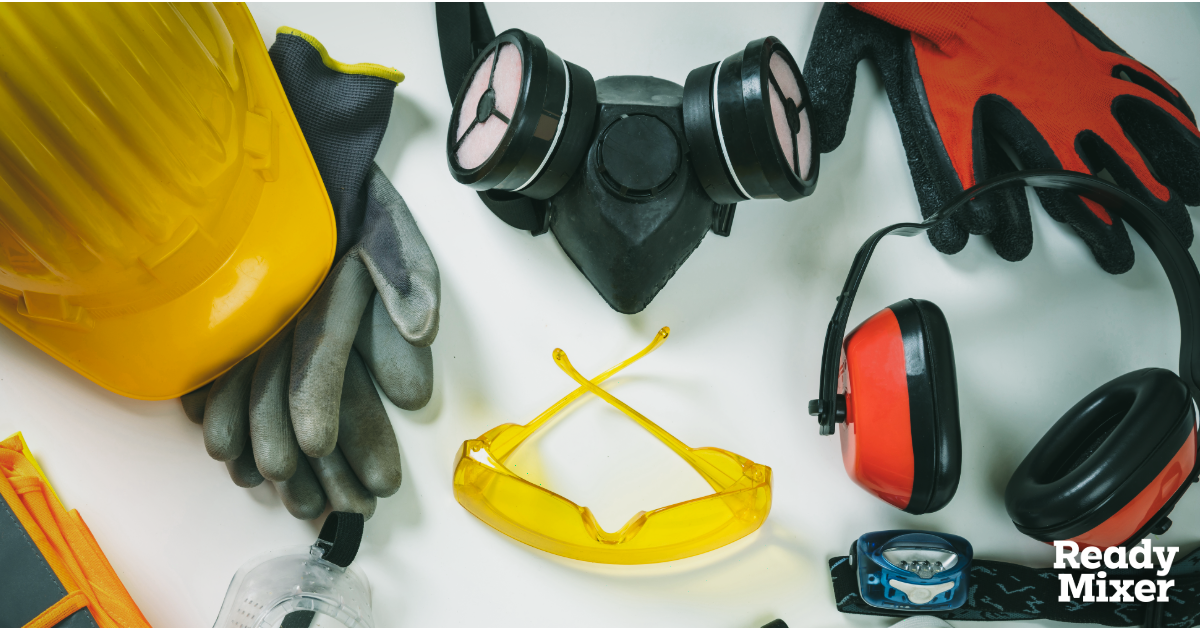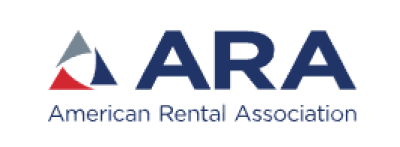Safety on a ready-mix site is no accident – it’s the result of planning, paying attention, and acting safely. Heavy mixers and site equipment create many hazards, so every team member must Think First before each task. The National Ready Mixed Concrete Association’s “Think First” campaign reminds us that common-sense habits save lives. Below are 10 easy-to-remember tips for ready mix crews – each backed by official safety guidance – to help you and your team stay safe.
Listen
Noise on the job can be intense around mixers, trucks, and saws, so protecting your hearing is crucial. In construction, about half of workers face dangerously loud noise, and many skip ear protection. Lost hearing isn’t just about long‐term health; if you can’t hear alarms, horns or coworkers’ warnings, you can miss hazards. OSHA notes that consistent use of hearing protection and monitoring can prevent irreversible damage. Listen up: When you hear a backup alarm, get clear of the truck. Before you start, double-check that your radio or intercom is working and turned up so you can hear instructions and alerts over background noise.
Safety Tip
Always wear earplugs or muffs when equipment is running, and make sure you can hear horns, beepers and spoken instructions. Treat hearing protection as part of your kit – it keeps you focused and able to “listen first.”
Communicate
Good communication is a safety tool. On busy sites with trucks coming and going, clear signals and brief talks keep everyone on the same page. OSHA emphasizes that all workers should know the hazards on site and how to control them. Before a pour or any task, hold a quick huddle – confirm who’s doing what, identify dangers (like moving vehicles or pump hoses), and agree on hand signals or radios. Call out any problems immediately: if a co-worker is in a blind spot or a mixer’s chute is swinging, shout a warning or sound the horn to keep your crew safe. Effective communication (including questions and feedback) makes sure no one is caught off-guard.
Safety Tip
Have a plan for communicating – use two-way radios or hand signals for spots where you can’t see each other. Always report hazards (for example, “Stop – form collapse!”) so everyone can fix the problem before someone gets hurt.
Sober Working is Safe Working
Operating a mixer or pump under the influence of drugs or alcohol is both illegal and dangerous. OSHA strongly supports drug-free policies for safety-sensitive work like driving heavy equipment. In fact, federal motor carrier rules flatly forbid it: no driver may be on duty with any detectable amount of alcohol or impairing drug in their system. Working tipsy or on drugs slows your reactions and impairs judgment, and that’s how injuries happen. Whether it’s an after‐work drink or prescription medicine, if it makes you drowsy or fuzzy, stay off the truck. Employers must keep workplaces free of “employees performing duties… under the intoxicating influence of alcohol or illicit drugs.”
Safety Tip
Arrive to work clear-headed and well-rested. If you feel “off” or you’re taking any medication that can cause drowsiness, tell your supervisor before climbing in. Never consume drugs or alcohol within hours of driving a ready-mix truck.
Always Wear Your Seatbelt
It might seem obvious, but buckling up is your first line of defense in a collision or tip-over. Federal law is crystal clear: “No driver shall operate a commercial motor vehicle… unless the driver is properly restrained by the seat belt assembly.” In other words, it’s not optional – it’s the law. Seat belts saved over 14,900 lives in 2017 alone. Even on short drives or slow backs on site, wearing a seat belt keeps you from being thrown against the cab interior or ejected.
Safety Tip
Buckle up immediately when you get in the truck. Make it a habit: click the belt before turning on the engine. Remind any passengers to buckle up too – they are required to wear belts in property-carrying trucks just like you.
Make Your First Move Forward
Backing accidents kill, especially in construction. OSHA highlights that over 70 workers died in a single year from backover incidents – when a vehicle reversed into someone. One NIOSH study found 143 workers were fatally struck by vehicles backing up between 2003–2010 (with 84 of those by dump or mixer trucks). One simple way to reduce this risk is the “First Move Forward” strategy: whenever possible, park so you can leave by driving forward, not reverse. That way, when your shift or pour is done, your first move will be out of a spot instead of backing up blindly.
Before you ever put the truck in reverse, stop and check your surroundings. Walk the backup path – look for people or obstacles. Use a spotter: have a co-worker stand where they can see blind spots and direct you. Keep your backup alarm on (they are required by law in many cases). If you need to reverse, back slowly, looking over both shoulders and at the mirrors. OSHA’s advice is clear: backovers are preventable, so take these precautions each time.
Safety Tip
Whenever you arrive or park, position the truck to pull forward out. If you must back up, use a spotter and backups alarms, and never rely only on mirrors. Always give yourself a clear view – this first move forward habit greatly cuts down on blindside accidents.
Know the Hazards Before Starting a Task
Every job has risks – from falling rebar to rotating drum parts. OSHA notes that failing to recognize hazards is a “root cause” of many injuries. That means it pays to stop and ask, “What could go wrong here?” before you begin. Do a quick walkthrough: check for slippery surfaces, unsecured materials, overhead cranes or energized equipment. Review any required permits or pre-job checklists. If a task seems unfamiliar or risky, ask a supervisor for guidance.
This hazard check should be routine. For example, before cleaning inside a mixer drum or servicing a pump, confirm the drum is locked out and the chutes are in a safe position. If you’re pouring concrete, note which way it will flow and plan your exit paths. Identifying the dangers in advance gives you time to control them – like moving tripping hazards, barricading high-traffic areas, or ensuring fall protection is in place. OSHA’s recommended practices urge employers and workers to proactively identify and assess hazards so injuries can be prevented.
Safety Tip
Always do a quick hazard hunt before each job. Talk it through with your crew, point out known dangers, and make sure everyone knows how to avoid them. A brief safety talk (toolbox talk) can highlight hazards and keep everyone alert.
Personal Protective Equipment (PPE) Only Works When Used
Hard hats, safety glasses, gloves, high-vis vests, steel-toed boots – you know the gear. But PPE only protects you if you actually wear it and wear it correctly. OSHA requires employers to provide the right PPE and ensure employees use it. On a ready-mix site, that means hard hats on at all times, eye protection when chipping or dealing with fly ash, dust masks when cleaning trucks, and any other gear needed for the task.
Don’t treat PPE like optional extra baggage – treat it like part of your uniform. Inspect your equipment each day: cracked goggles or worn earplugs need immediate replacement. If a co-worker isn’t wearing required PPE, speak up. Remember, inconsistent safety policies are dangerous: OSHA warns that if some workers skip hats or vests, others might mistakenly do the same and get hurt. Wearing PPE might seem cumbersome, but it stops cuts, chemical splashes, impacts, and more – exactly what we need on a concrete site.
Safety Tip
Gear up fully before every task. Make PPE the first thing you put on at work. Regularly check your helmet, glasses, and other gear for damage, and don’t start work until every person has their PPE properly in place.
Always Use Three Points of Contact
Getting in and out of a mixer truck or climbing a ladder means you need stability. OSHA calls it the “three points of contact” rule: keep two feet and one hand (or two hands and one foot) on the vehicle/ladder at all times when climbing or descending. This rule helps prevent falls and crush injuries from slips. For example, when stepping onto a rear mixer platform or ladder, never hold a tool in both hands – keep at least one hand free to grip a rung or rail.
Even if you’ve done it a hundred times, don’t take shortcuts like jumping off, standing on machinery parts, or carrying coffee while sliding down the ladder. Hold onto the handrail with one hand and face the ladder as you climb; use the designed steps and handholds on trucks. This isn’t OSHA just being picky – their ladder standards explicitly aim to keep you in three-point contact when climbing. By always using three points of contact, you dramatically reduce fall risks.
Safety Tip
When mounting or descending trucks and equipment, always have two limbs on the ladder or steps and one hand holding a rail. If you need to carry something, put it in a bucket or hand it up after you’re positioned safely.
The Dangers of Shortcuts
Cutting corners to save time can have deadly consequences. OSHA recounts cases where “working out of sequence” or skipping a step led to severe injuries. In one report, a worker bypassed a safety step and lost fingers when the machine wasn’t properly shut down. It’s human nature to rush a task, but that’s when accidents happen. If procedures say to lock out power or set the brakes, do it every time – there’s no excuse when lives are at stake.
For instance, don’t skip walking around to spot trip hazards before moving a truck. Don’t ignore a cracked ladder rung because you’re in a hurry. If instructions say to lower a chute slowly, do it – jerking it down might seem faster, but it risks breaking equipment or hurting someone. Remember the OSHA case: even though procedures were available, the worker admitted his injury “was a result of his cutting corners”.
Safety Tip
Follow every safety step, no matter how minor it seems. Take the extra 10 seconds to turn off and lock out machinery, double-check clearances, or slow down the pour. Skipping these steps is never worth the risk.
Stay Alert and Focused
Distractions and fatigue are hidden killers on the road and the site. OSHA warns that any non-driving task – texting, eating, even deep conversation – takes your focus off the vehicle and increases crash risk. On-site, a moment’s lapse (like checking a phone) can mean missing a co-worker stepping behind your truck. Similarly, drowsy driving is basically impaired driving in disguise. OSHA notes that being awake 24 hours straight has the same effect on reflexes as a blood-alcohol level of .10.
Concrete crews often work long hours, but you must know your limits. If you’re yawning or find your mind wandering, pull over at the next break for coffee or a rest. Rotate tasks to avoid monotony – a short break to stretch or drink water can reset your focus. Store mobile phones out of reach while driving or use hands-free if needed for job-critical calls. The bottom line: keep your eyes on the task (or road) and your mind in the present.
Safety Tip
Stay disciplined: silence personal distractions and take regular rest breaks. If you feel tired, ask for help or let dispatch know. Remember OSHA’s warning: fatigue blurs your alertness like alcohol would.
Think First – Keep Safety in Mind
Every tip above ties back to one mindset: Think First. Pause and ask “What could go wrong?” before lifting a hose, stepping on a platform, or hitting the ignition. As the NRMCA emphasizes, having the whole workforce think first decreases injuries and fatalities and builds positive morale on site. When you make these safety habits – listening for warnings, talking with your crew, staying sober and alert, and never cutting corners – second nature, they become part of your routine. In turn, the job site becomes safer for everyone, and we all go home in one piece.
Stay sharp, stay safe, and always Think First.






